
Cotyledon is one of some 35 genera of succulent plants in the family Crassulaceae. Mostly from Southern Africa, they also occur throughout the drier parts of Africa as far north as the Arabian Peninsula. Ten of its species are mostly confined to South Africa, where unlike Tylecodon, they occur commonly in both the winter and summer rainfall regions. They may be found on coastal flats and rocky hillsides, or as cremnophytes on cliff faces. Their decussate, evergreen leaves are very variable in shape, even within some species, but the flowers are, apart from colour, very similar.

Gazania rigens, sometimes called treasure flower, is a species of flowering plant in the family Asteraceae, native to coastal areas of southern Africa. It is naturalised elsewhere and is widely cultivated as an ornamental plant.
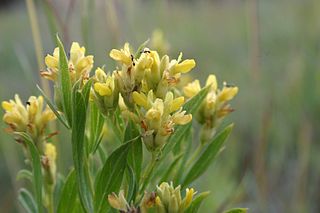
Pearsonia is a genus of 12 species of plants belonging to the family Fabaceae and occurring in Africa south of the equator with 1 species found on Madagascar. The species are usually herbs or shrublets with woody rootstocks. Leaves are usually sessile and 3-foliolate. The inflorescence is a congested or lax terminal raceme. The name of this genus commemorates the South African botanist Henry Harold Welch Pearson.
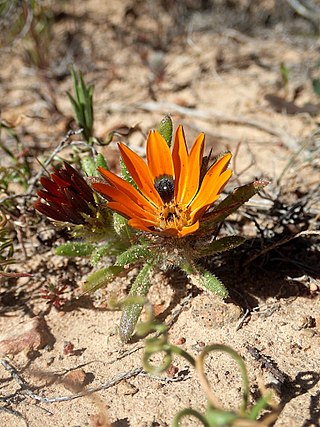
Gorteria is a genus of small annual herbaceous plants or shrubs, with 8 known species, that is assigned to the daisy family. Like in almost all Asteraceae, the individual flowers are 5-merous, small and clustered in typical heads, and are surrounded by an involucre, consisting of in this case several whorls of bracts, which are merged at their base. In Gorteria, the centre of the head is taken by relatively few bisexual and sometimes also male, yellow to orange disc florets, and is surrounded by one complete whorl of 5–14 infertile cream to dark orange ray florets, sometimes with a few ray florets nearer to the centre. None, some or all of them may have darker spots at their base. The fruits remain attached to their common base when ripe, and it is the entire head that breaks free from the plant. One or few seeds germinate inside the flower head which can be found at the foot of plants during their first year. The species flower between August and October, except for G. warmbadica that blooms mostly in May and June. The species of the genus Gorteria can be found in Namibia and South Africa.

Microloma is a small genus of Ceropegia-like twiners and twiggy bushes occurring in mainly arid or fynbos regions in South Africa. They are generally nondescript when not in bloom, but the flowers of most species are incongruously decorative.

Serruria fasciflora or common pin spiderhead is a species of flowering plant in the family Proteaceae. It is a sprawling to upright shrublet of 40 cm to 1 m high and about 1⁄2 m wide. It has finely divided, upward curving leaves with thread-thin segments and clusters of sweetly scented heads, each consisting of five to seven silvery pink flowers, that may be found year-round, but mostly from May to December. It is a rather widespread and common species, that is restricted to the south of the Western Cape province of South Africa.

Oedera capensis is a prickly shrublet belonging to the family Asteraceae. It has stems that branch only at the foot and are densely set over their entire length with narrowly triangular leathery leaves with a sharp tip at approximately right angles to the stem. At their tip are what at first sight appears to be a single flowerhead with yellow ray florets and yellow disc florets. In fact, these are mostly nine densely cropped heads, as is suggested by the nine domes of the "disc" of the composite head, the untidy arrangement of the ray florets, and becomes very clear when cutting through the composite head. It is an endemic of the south of the Western Cape province in South Africa.

Crassula subaphylla is a succulent plant belonging to the family Crassulaceae. It is widespread in the Karoo regions of South Africa and Namibia.

Oedera squarrosa ("Vierkant-perdekaroo") is a prickly shrublet belonging to the family Asteraceae.
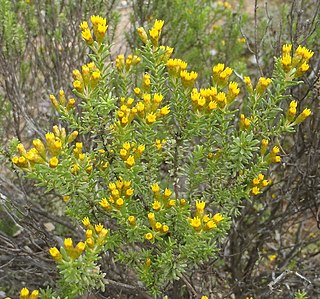
Oedera genistifolia is a prickly shrublet belonging to the family Asteraceae.
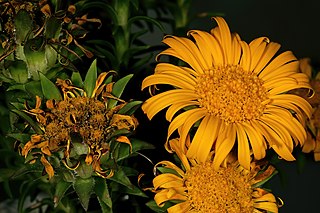
Oedera imbricata is a prickly shrublet belonging to the family Asteraceae.
Relhania speciosa is a shrublet belonging to the daisy family, indigenous to the southern Cape, South Africa.
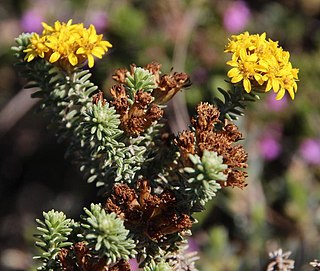
Relhania garnotii is a shrublet belonging to the daisy family, indigenous to the southern Overberg region of the Western Cape Province, South Africa.
Relhania calycina is a shrublet belonging to the daisy family. It is found in rocky Fynbos and Renosterveld vegetation, growing in rocky, loamy or sandy soil, in the Western Cape Province and Eastern Cape Province, South Africa.
Asparagus burchellii, is a shrub of the Asparagus genus, that is indigenous to dry scrub vegetion in the southern Cape region, South Africa.

Otholobium saxosum is a small shrublet of up to 20 cm (7.9 in) high that has been assigned to the Pea family, with branches upright or horizontal at the base with rising tips. It has sessile, clover-like leaves and white, pea-like flowers that grow in triplets in the axils of the upper leaves of new, short side shoots. The species is only known from Garcia's Pass in Western Cape province of South Africa. Flowering occurs in October and November.
Lobostemon decorus, the Rooiberg healthbush, is a species belonging to the forget-me-not family. It is endemic to the Western Cape of South Africa.

Selago ramosissima is a species of plant in the family Scrophulariaceae. It is endemic to the Western Cape, South Africa.
Selago aspera is a species of plant in the family Scrophulariaceae. It is endemic to the southern Cape Provinces, South Africa.
Selago thomii is a species of plant in the family Scrophulariaceae. It is endemic to the Western Cape, South Africa.














